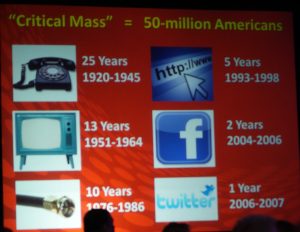Though recorded in 1964 by Bob Dylan as the title track for the album by the same name, The Times They Are A-Changin' applies today as well as it did 50 years ago. Ira Bloomenthal, the CSI national convention keynote speaker used Dylan's song title to explain change is inevitable; growth is optional. By embracing change you can reach distinction, and by ignoring change, extinction.
Will you be ready for what is next?
Technology is racing ahead. Knowledge of building science is exploding. Our industry is trying to catch up, but may be falling behind. Change is exponential. Today, it seems the rate of change is also exponential. Ira shared the slide above showing the time it took for technology to reach critical mass in the United States. Tools and methods used today are likely to be obsolete in 10 years or less.
Are you prepared for the next quantum leap?
Will plotted drawings be necessary? Will separate written construction specifications exist? Will Building Information Models (BIM files) be so data rich that additional documents become obsolete?
Specifiers must begin to think beyond producing project manuals. The value proposition of specifiers is much greater than turning architects' product selections into written contract requirements. Specifiers provide a value beyond written documents. This value, however, is often hidden from the ultimate beneficiary - the Owner.
The Specifier's role is a-changin'. If you ask Greg Markling, CSI's immediate past-president, he will tell you the new role will be Building Information Manager (BIM professional). Yes, a new twist on the acronym with an entirely different meaning. Whether this term takes root or not remains to be seen. Meanwhile, be careful you understand the meaning of BIM, in context. It may be well worth asking if the discussion is about files or a professional.
Specifiers as Data Managers
Who is advising the design team about product selections, appropriate product applications, system and assembly interfaces, and relative costs of alternatives? The Specifier!
The Specifier's services are not new, but can be put to a new use and an added value to the entire project team - and especially the owner. The Specifier because of the technical knowledge, can collect, distill, input, and manage the data embedded in BIM files. It is a natural fit. Data discovery is the first step for writing specifications. So the process does not change. Only the method of organizing and presenting the data changes
Future Specifications
If the data will reside in BIM files, associated with model objects, is our preferred specification organization soon to be obsolete? MasterFormat® is the industry standard for construction specification organization. UniFormat™, used for preliminary project descriptions (PPDs) and project estimates, is organized by systems and assemblies that correspond to BIM file objects. Let me repeat: PPDs, estimates, and BIM file objects are all arranged by UniFormat™. Might specifications they be a-changin' too? It makes sense that consistently organized data will be easier to manage, analyze, and evaluate to make well informed decisions about construction projects.
Future Specifiers
Regardless whether the specifications move to a UniFormat™ organizational structure, specifiers should be involved in construction projects from day one. Why?
The design team must understand the Owner's Project Requirements (OPR) that will ultimately be used to commission the completed project. Because PPDs document the performance requirements for the building function elements, they are the perfectly suited to capture the OPR. Moreover, as the design solution for the project develops, the information can be captured in the PPD, as the data becomes available.
The PPD, then, will help manage the project risk by:
- Documenting the Owner's project requirements, including functional performance and budget,
- Logging the development of designed solutions for systems and assemblies,
- Recording decisions about alternative solutions, and
- Providing the commissioning basis for verifying the design meets the owner's expectations.
Specifiers are trained to ferret out data, to critically analyze information, and to present impartial recommendations for the benefit of the entire project team, especially the Owner. Because specifications control the project quality, the Specifier is ideally suited to advise the team to help ensure the completed project will meet the Owners expectations.

